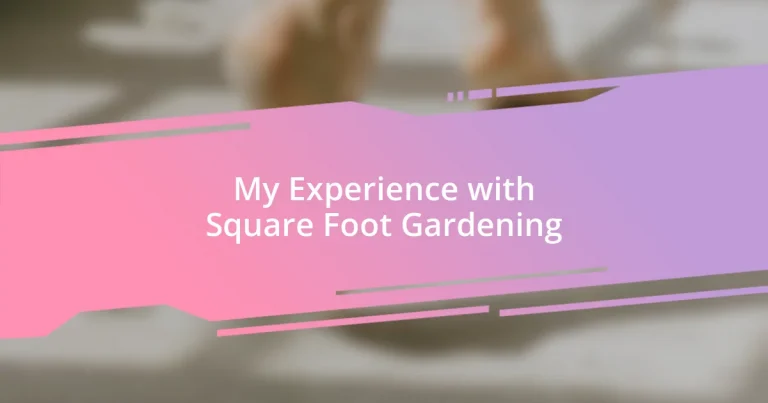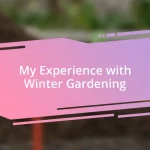Key takeaways:
- Square Foot Gardening maximizes space and yields by allowing diverse crops in a compact area, making it efficient and manageable for beginners.
- Creating the right soil mix with equal parts compost, peat moss, and vermiculite is crucial for healthy plant growth and moisture retention.
- Regular maintenance, including consistent watering and fertilizing, enhances plant health, leading to a more fruitful and rewarding harvest experience.
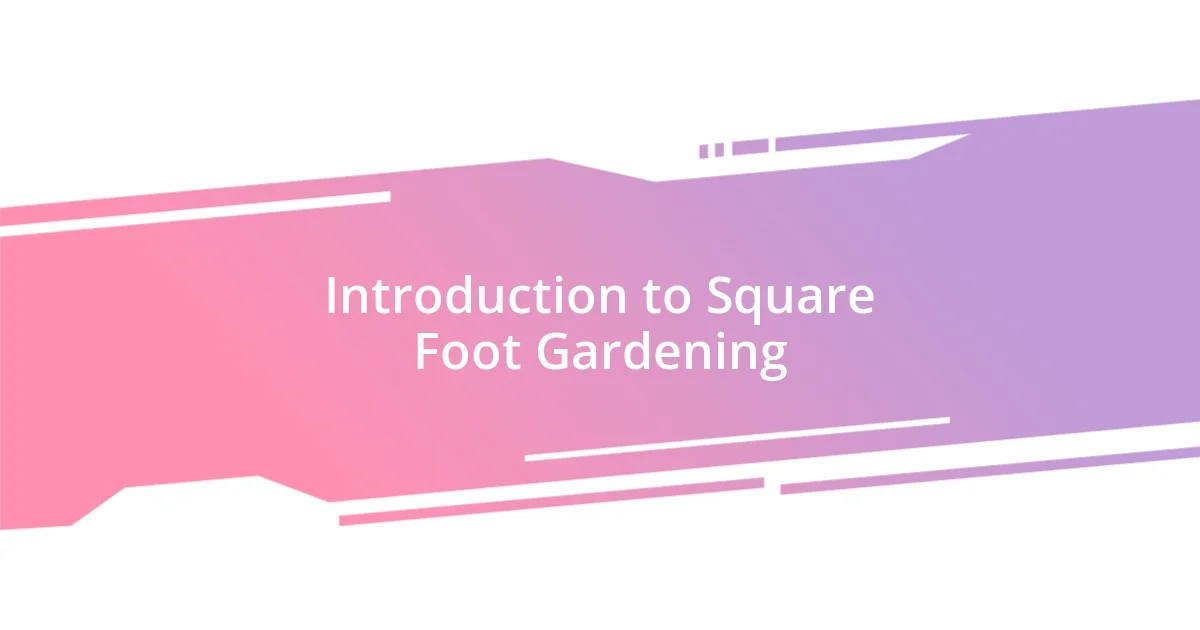
Introduction to Square Foot Gardening
Square Foot Gardening is an innovative method that truly transformed my approach to gardening. When I first stumbled upon this technique, I was intrigued by the idea of growing a variety of plants in a compact space. It felt like a revelation—could I really cultivate an entire garden in just a square foot?
What I love about this method is its simplicity and efficiency. Each square foot is used purposefully, allowing me to maximize my yield and minimize wasted resources. I remember the thrill I felt, since I could easily plan my layout and even experiment with different crops. One year, I created a little salad patch right in my backyard and experienced the joy of fresh greens just steps away from my kitchen.
As I delved deeper into the world of Square Foot Gardening, I discovered it not only nurtured my plants but also my love for gardening itself. It was empowering to see how even a novice could yield a bountiful harvest with a little planning and care. Have you ever experienced that rush of excitement watching your efforts bloom—literally?
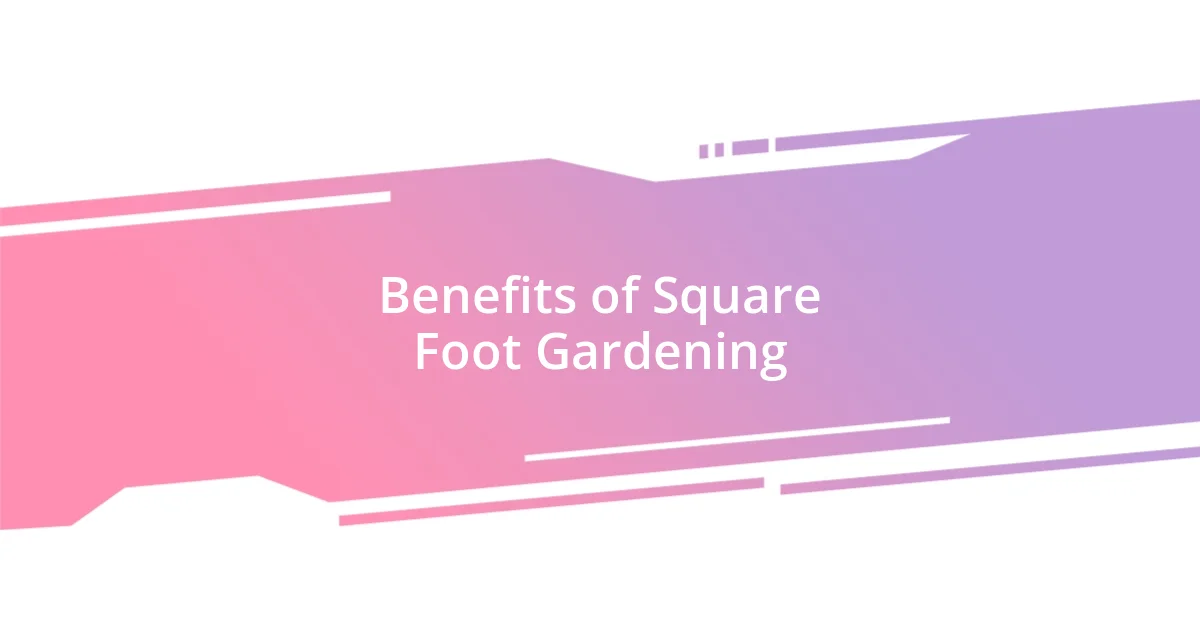
Benefits of Square Foot Gardening
Square Foot Gardening completely changed my perception of how much I could grow in a limited space. I was amazed to discover how efficient this method is. It allows me to cultivate multiple types of plants without the overwhelming feeling often associated with traditional garden rows. I remember my first attempt; I was shocked at how many different vegetables I could fit into just a small grid. Not only did I have a colorful patch of greens, but I also enjoyed the satisfaction of knowing I was making the most out of every inch.
Here are some key benefits I’ve experienced:
- Space Efficiency: Even small yards can become productive gardens.
- Reduced Weeding: With soil-intensive methods, weeds are less of an issue.
- Diverse Crops: Grow an array of vegetables, herbs, and flowers in one place.
- Less Water Usage: Watering is simplified and often more efficient.
- Easier Maintenance: It’s manageable, even for busy schedules.
Every garden square becomes an opportunity—one I wish I had known about sooner!
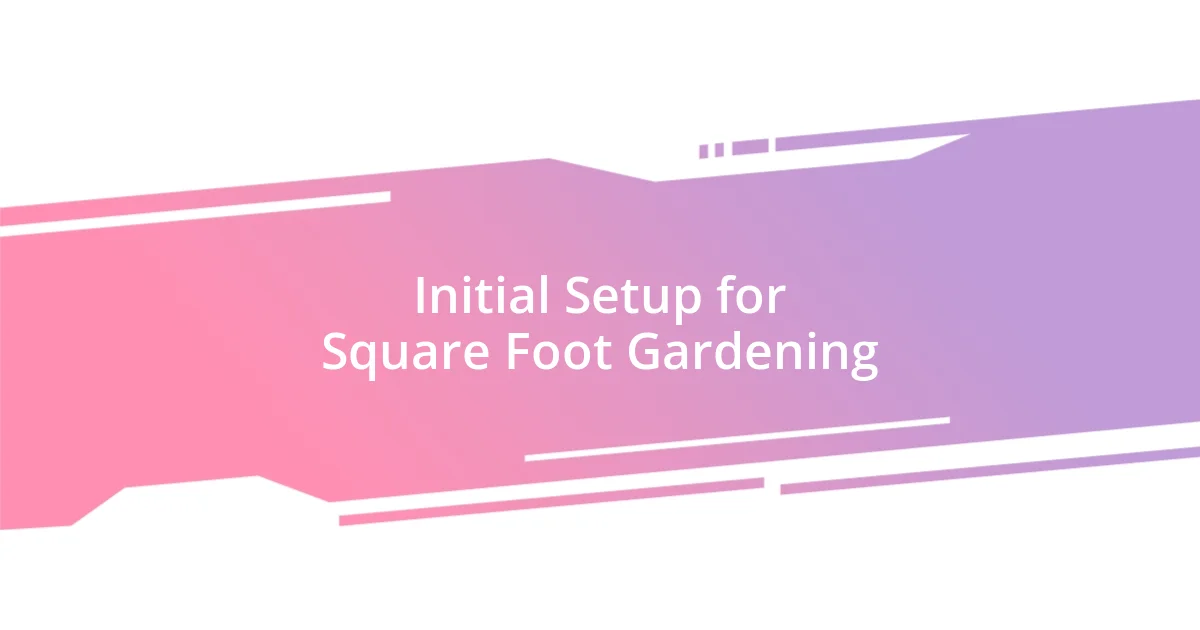
Initial Setup for Square Foot Gardening
Setting up a Square Foot Garden can feel overwhelming at first, but it’s truly a rewarding process. I vividly remember the day I measured and built my first wooden frame. The excitement bubbled up inside me as that square structure started taking shape in my yard, marking the spot where my gardening endeavor would flourish. Choosing the right location is crucial; I found a sunny spot with decent drainage, which made all the difference during those crucial first weeks.
The soil mix is equally important. I opted for a blend of compost, peat moss, and vermiculite, creating a rich, fluffy medium that my plants thrived in. I still recall the aroma of fresh soil as I mixed these components, with the feeling that I was nurturing life right from the ground up. It’s such a unique and sensory experience when you create the perfect environment for your plants.
Lastly, don’t forget to plan your layout! I used graph paper to sketch out my grid and map where each crop would go, which helped me visualize my garden. A little preparation now can save a lot of headaches later on. I still smile thinking about watching my little squares come to life, each one a mini garden plot bursting with potential.
| Step | Details |
|---|---|
| Building the Frame | Construct a wooden frame, ideally 4×4 feet, to create your garden grid. |
| Choosing Soil | Use a mix of compost, peat moss, and vermiculite for optimal growth. |
| Planning Layout | Sketch your layout on graph paper for efficient planting of various crops. |
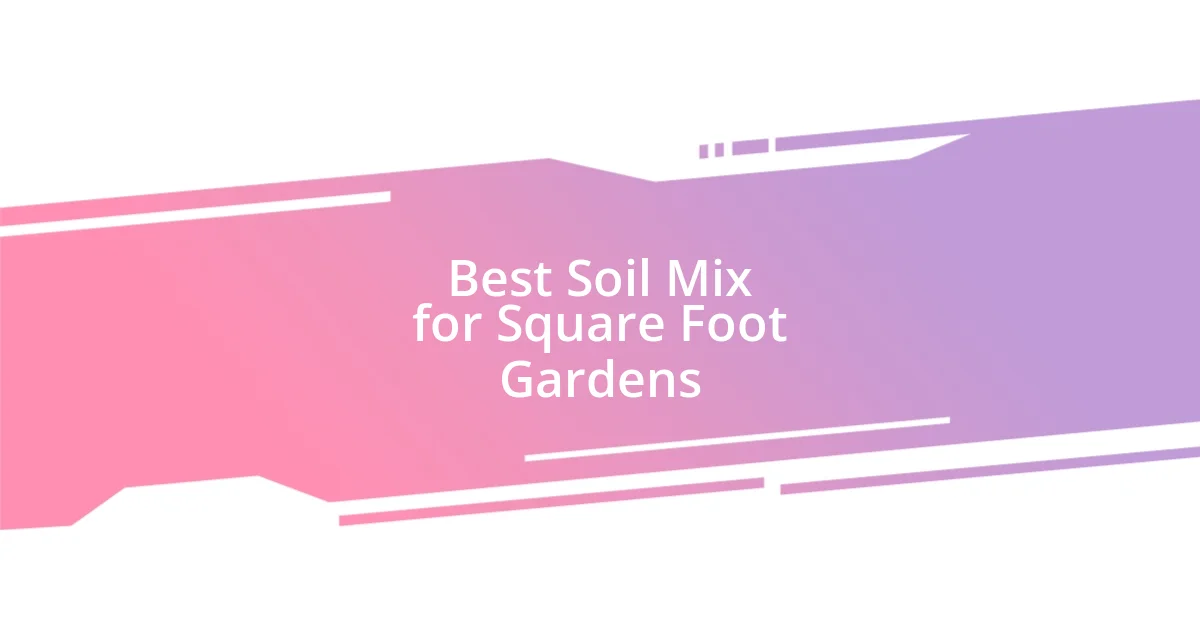
Best Soil Mix for Square Foot Gardens
Creating the right soil mix for Square Foot Gardening is essential to ensuring your plants thrive. In my case, the first time I mixed my soil, I felt a mix of excitement and anxiety. Did I have the right proportions? I found that using a combination of one-third compost, one-third peat moss, and one-third vermiculite worked wonders. This blend provided excellent drainage while keeping the soil light and airy.
I remember observing how my plants reacted to this mix. My tomatoes grew sturdy and robust, while my lettuce thrived, producing crisp leaves. The vermiculite maintained moisture, which was a lifesaver on those hot summer days. Have you ever seen a plant flourish right before your eyes? It’s incredibly rewarding to know that a proper soil mix can make such a difference.
Over time, I’ve refined my approach, incorporating more organic matter like well-rotted manure or worm castings to enrich the mix further. With each season, I feel more confident in my gardening choices. I now understand that the foundation—my soil—is the heart of a successful garden. What will your soil mix look like, and how will it support your gardening journey? Trust me, investing time in your soil will pay off in the growth you see.
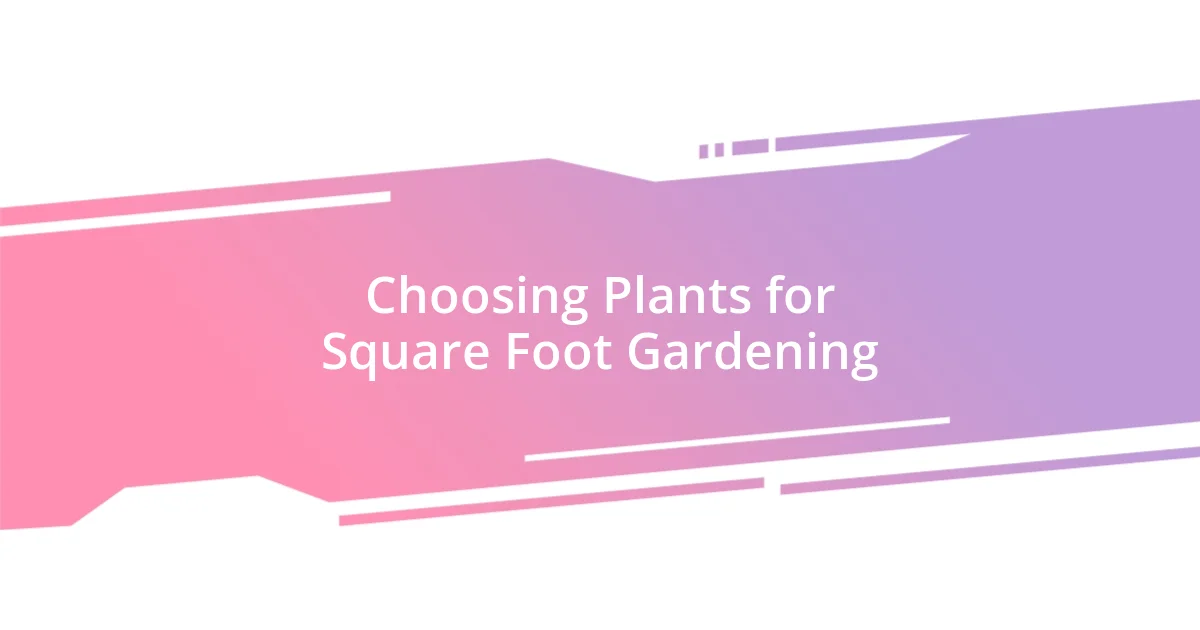
Choosing Plants for Square Foot Gardening
Choosing the right plants for your Square Foot Garden can truly elevate your gardening experience. I remember the first time I stood in front of the seed racks, feeling both elated and overwhelmed. With limited space, I had to be strategic. That’s when I realized that certain plants, like radishes and bush beans, are quick to mature and can provide excellent yields in a tiny area. Have you ever tried planting something just to watch it grow in a matter of weeks? It sparked such joy for me!
Consider companion planting as well; this practice was a game changer for me. I learned that pairing certain plants can enhance growth and deter pests. For instance, I was thrilled to discover that planting marigolds alongside my vegetables helped keep the bugs at bay. Watching my tomatoes and peppers thrive while being protected brought such satisfaction. It’s almost like having a little ecosystem working harmoniously.
Don’t shy away from experimenting either. I vividly recall when I decided to introduce herbs like basil and cilantro into the mix. Their fragrance wafting through the garden was a sensory delight, and having fresh herbs on hand felt like a luxury I could easily afford. The best part? They took up little space while adding so much flavor to my meals. What unique combinations will you discover in your own garden?
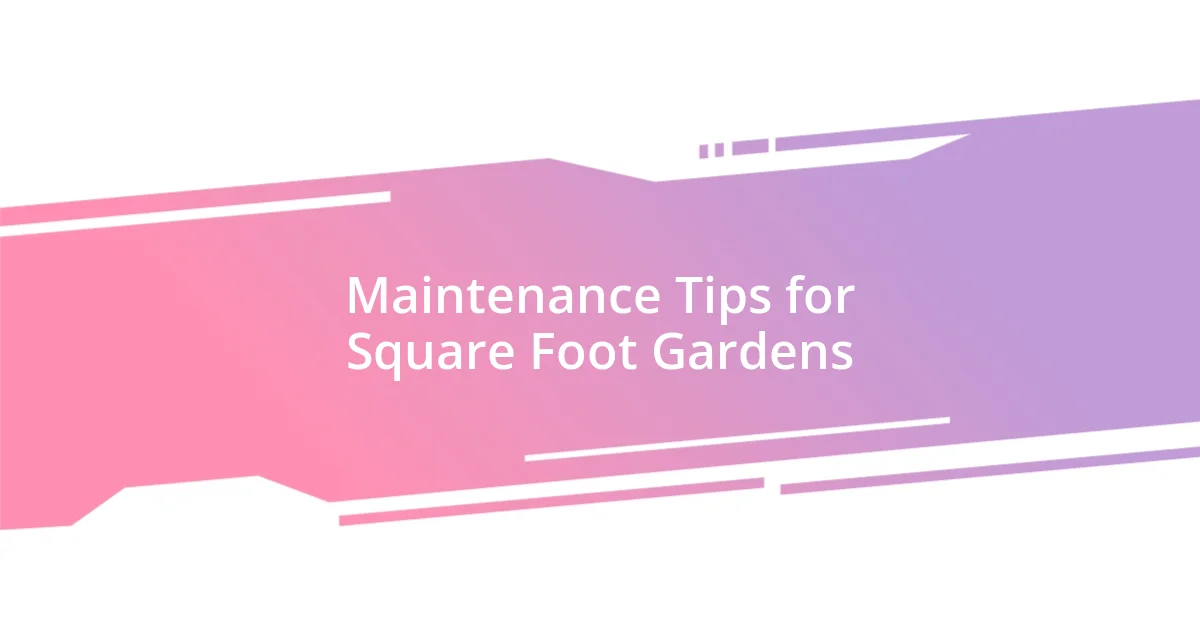
Maintenance Tips for Square Foot Gardens
To keep your Square Foot Garden thriving, regular maintenance is key. I learned quickly that watering consistently is vital, especially during dry spells. In my garden, I found that checking the soil’s moisture before watering helped me avoid over-saturating my plants. Have you ever experienced the disappointment of overwatering? It can lead to root rot, and that’s a gardener’s nightmare.
Weeds can be relentless, but pulling them out by hand works wonders in a square foot setup. I remember one day, armed with my gloves and a small trowel, I diligently removed weeds right after a rain. The soil was soft, making it easier to pull them up, and I couldn’t help but feel a sense of accomplishment as I cleared the space for my vegetables. Staying on top of weeds makes sure your plants have all the nutrients they need.
Finally, don’t forget about fertilizing throughout the growing season! I’ve made it a habit to add a bit of organic fertilizer every few weeks. One summer, I noticed how this simple step helped my peppers produce an abundance of vibrant fruit. It was a joy to watch them flourish. Have you included regular feeding in your garden care routine? It’s something I wish I had paid more attention to in my early days, but now, it feels like the secret to lifting my gardening game.
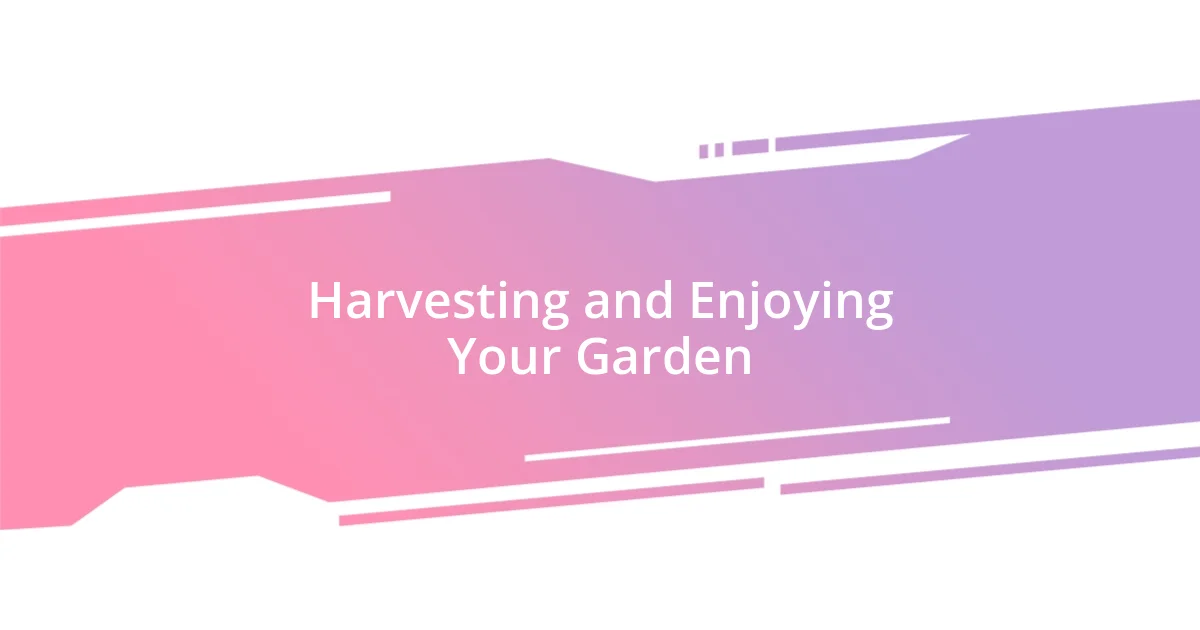
Harvesting and Enjoying Your Garden
When the time comes to harvest, I can’t help but feel excited. It’s not just about gathering produce; it’s a celebration of my hard work and patience. I remember the first time I pulled out a handful of carrots—adorably small and vibrant orange. The look of those freshly harvested roots brought a huge smile to my face. Have you ever savored the sweetness of a homegrown carrot? It’s a taste that supermarket veggies simply can’t compete with.
As I’ve harvested, I’ve grown increasingly aware of the small joys in the process. I often take a moment to admire the colors and textures of my crops before bringing them inside. Each cucumber or tomato feels like a little trophy that represents my dedication. I love to think of creative ways to enjoy them too! I recall a summer when my garden overflowed with zucchini; I whipped up a delightful ratatouille that filled my kitchen with the scents of home. What delicious creations will you cook up from your garden bounty?
There’s also something profoundly satisfying about sharing the harvest. I vividly recall gifting a basket of fresh tomatoes to my neighbor. Her surprise and delight were rewarding, and it opened a lovely conversation about gardening tips. It made me realize how rewarding it is to connect with others through the fruits of my labor. Have you thought about involving friends and family in your gardening journey? Sharing not only doubles the joy but also fosters a sense of community that makes gardening even more enjoyable.












